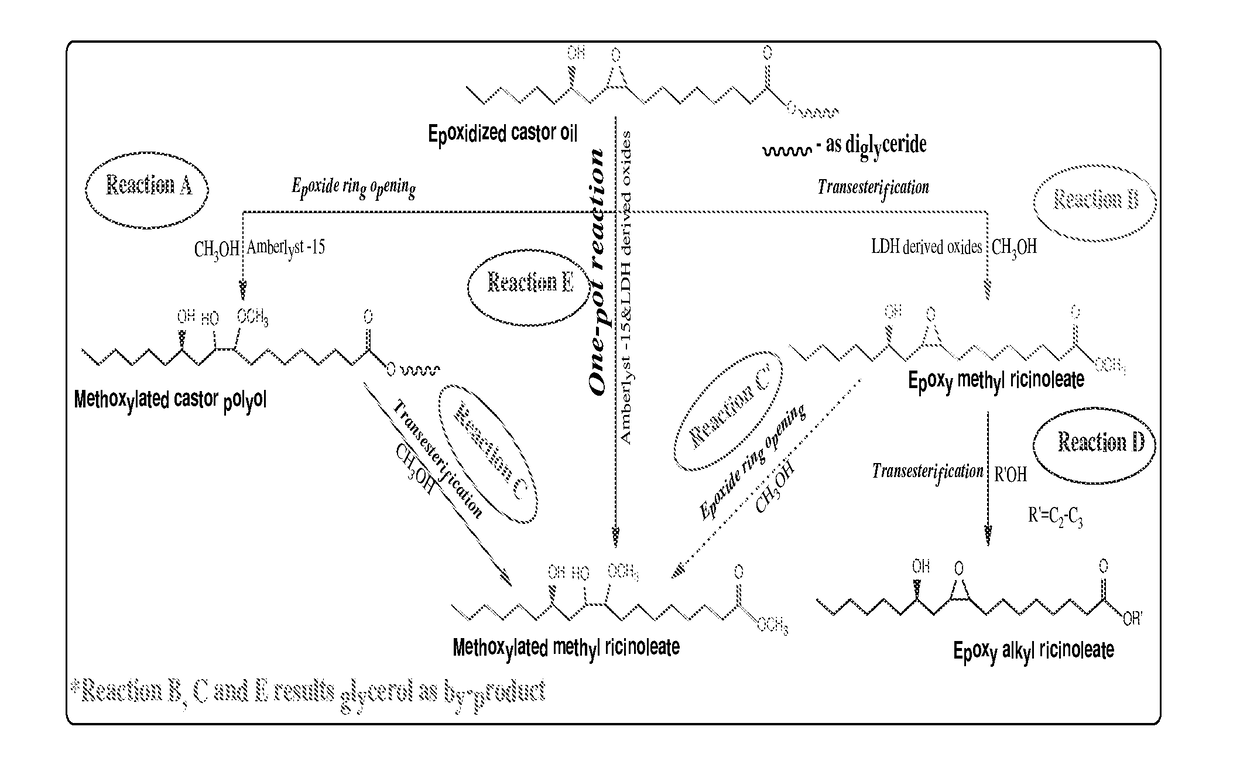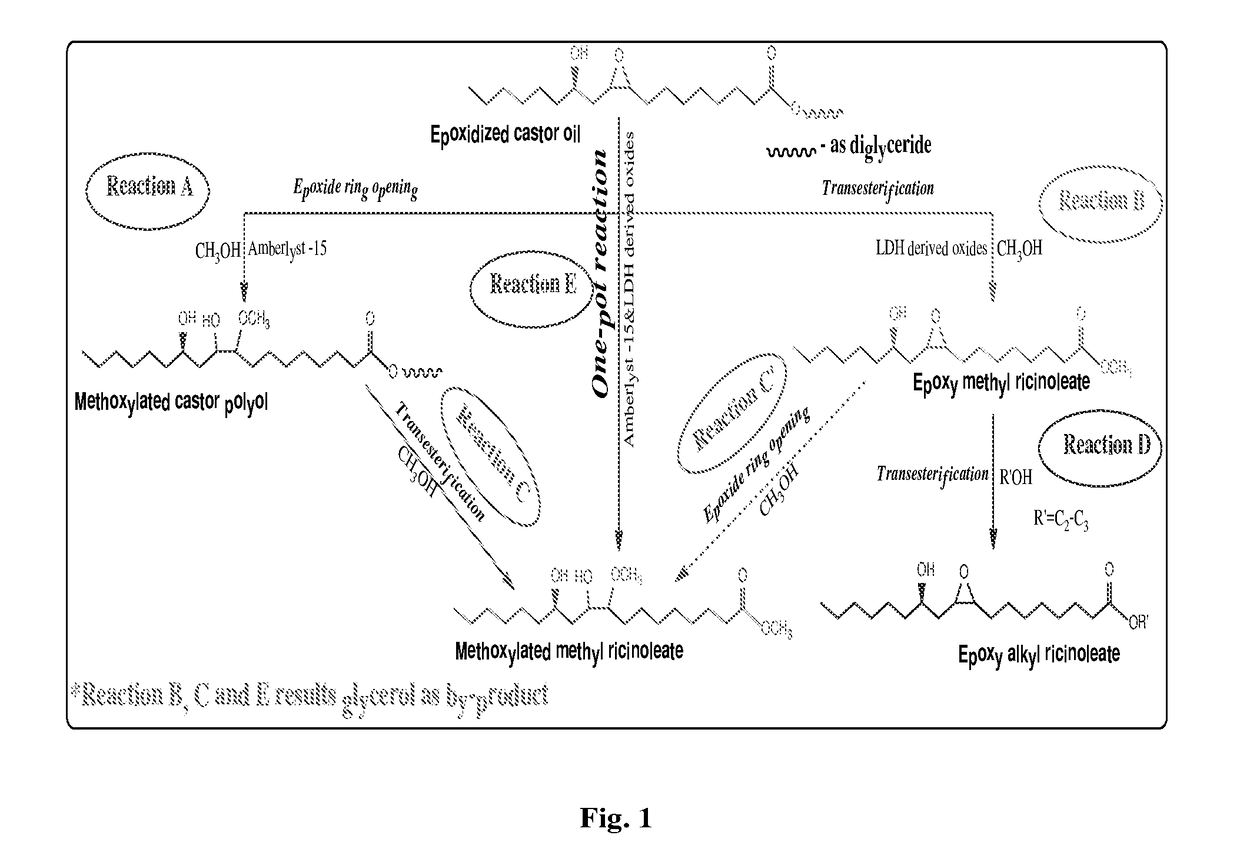Preparation of functionalized castor oil derivatives using solid acid and base catalysts
a technology of solid acid and base catalyst, which is applied in the direction of fatty acid chemical modification, organic chemistry, chemistry apparatus and processes, etc., can solve the problems of longer reaction time (15 h) and main drawback of process, and the use of homogenous phosphoric acid as catalyst is the main drawback, and the time required to prepare active catalysts is longer
- Summary
- Abstract
- Description
- Claims
- Application Information
AI Technical Summary
Benefits of technology
Problems solved by technology
Method used
Image
Examples
examples
[0066]Following examples are given by way of illustration and therefore should not be construed to limit the scope of the invention.
Example: 1
[0067]500 mg of epoxidized castor oil (shortly ECO; Mol. wt. ˜980) and 1 g of methanol (Methanol:ECO molar ratio=60:1) were taken along with 5 ml of toluene in a 25 ml round bottom (R.B.) flask at 27° C. 25 mg (5 wt. % w.r.t. oil) of solid acid catalyst (except MgAl3-LDH which is basic in nature) was added to the flask. The flask was then placed in a preheated oil bath at 60° C. and stirred well for 4 h. Catalyst (resin catalysts) was separated from the reaction mixture by simple decantation (sulphated zirconia and MgAl3-LDH were separated by centrifugation). Excess methanol and toluene were distilled out to get the ring-opened product and the solvent free sample was analyzed by 1H NMR. The conversion of ECO was 9-34% and the results are given in Table 1.
TABLE 1Ring opening of ECO using different catalystsCatalystConversion of ECO (%)Amberlite...
example 7
[0073]100 g of ECO (viscosity=4625 cP at 25° C.) and 200 g of methanol (methanol:oil molar ratio=60:1) were taken along with 100 ml of toluene in a 500 ml R.B. flask at 27° C. To that 10 g (10 wt. % w.r.t. oil) of Amberlyst 15 was added to the flask. The flask was then placed in a preheated oil bath at 105° C. and stirred well for 4 h. Further processes were done as mentioned earlier in Example: 1. The derived product methoxylated castor polyol (MCP) showed viscosity of 1020 cP at 25° C. and oxidative stability of 42552 and 44 h at 30 and 110° C. respectively. Isopropoxylated castor polyol (IPCP) was prepared by taking 50 g of ECO and 125 g of iso-propanol along with 50 ml toluene in a 250 ml R.B. flask at 27° C. To that 5 g (10 wt. % w.r.t. oil) of Amberlyst 15 was added to the flask. The flask was then placed in a preheated oil bath at 105° C. and stirred well for 4 h. Further processes were done as mentioned earlier in Example: 1. IPCP showed viscosity of 4007 cP at 25° C. and ox...
example 8
[0075]500 mg of ECO and 3 g of methanol (Methanol:ECO molar ratio=180:1) was taken along with 3 ml of toluene in a 25 ml R.B. flask at 27° C. 50 mg (10 wt. % w.r.t. oil) of Amberlyst 15 was added to the flask. The flask was then placed in a preheated oil bath at 105° C. and stirred well for 4 h. Further processes were done as mentioned earlier in Example: 1.
TABLE 3Reusability of the Amberlyst 15 catalyst for ring-opening of ECOCycle numberConversion of ECO (%)182272365463
[0076]The collected catalyst was washed well with toluene and dried in oven at 100° C. for 1 h. Oven dried catalyst was used for next cycle by following the above mentioned procedure and the conversion of ECO was in the range of 82-63% (Table 3).
Example: 9
[0077]5 g of ECO and 3 g of methanol (methanol:ECO molar ratio=18:1) were taken in a 25 ml R.B. flask at 27° C. 250 mg of (5 wt. % w.r.t. oil) of oxides derived from CaAl-LDH was added to the flask. The flask was then placed in a preheated oil bath at 65° C. and st...
PUM
| Property | Measurement | Unit |
|---|---|---|
| Temperature | aaaaa | aaaaa |
| Temperature | aaaaa | aaaaa |
| Fraction | aaaaa | aaaaa |
Abstract
Description
Claims
Application Information
 Login to View More
Login to View More - R&D
- Intellectual Property
- Life Sciences
- Materials
- Tech Scout
- Unparalleled Data Quality
- Higher Quality Content
- 60% Fewer Hallucinations
Browse by: Latest US Patents, China's latest patents, Technical Efficacy Thesaurus, Application Domain, Technology Topic, Popular Technical Reports.
© 2025 PatSnap. All rights reserved.Legal|Privacy policy|Modern Slavery Act Transparency Statement|Sitemap|About US| Contact US: help@patsnap.com



